

A treaty can appear in the UNTS via a few different pathways. The chart belows provides a visual summary of when you can expect a treaty to be in the UNTS and if it is not there, where else you might look.
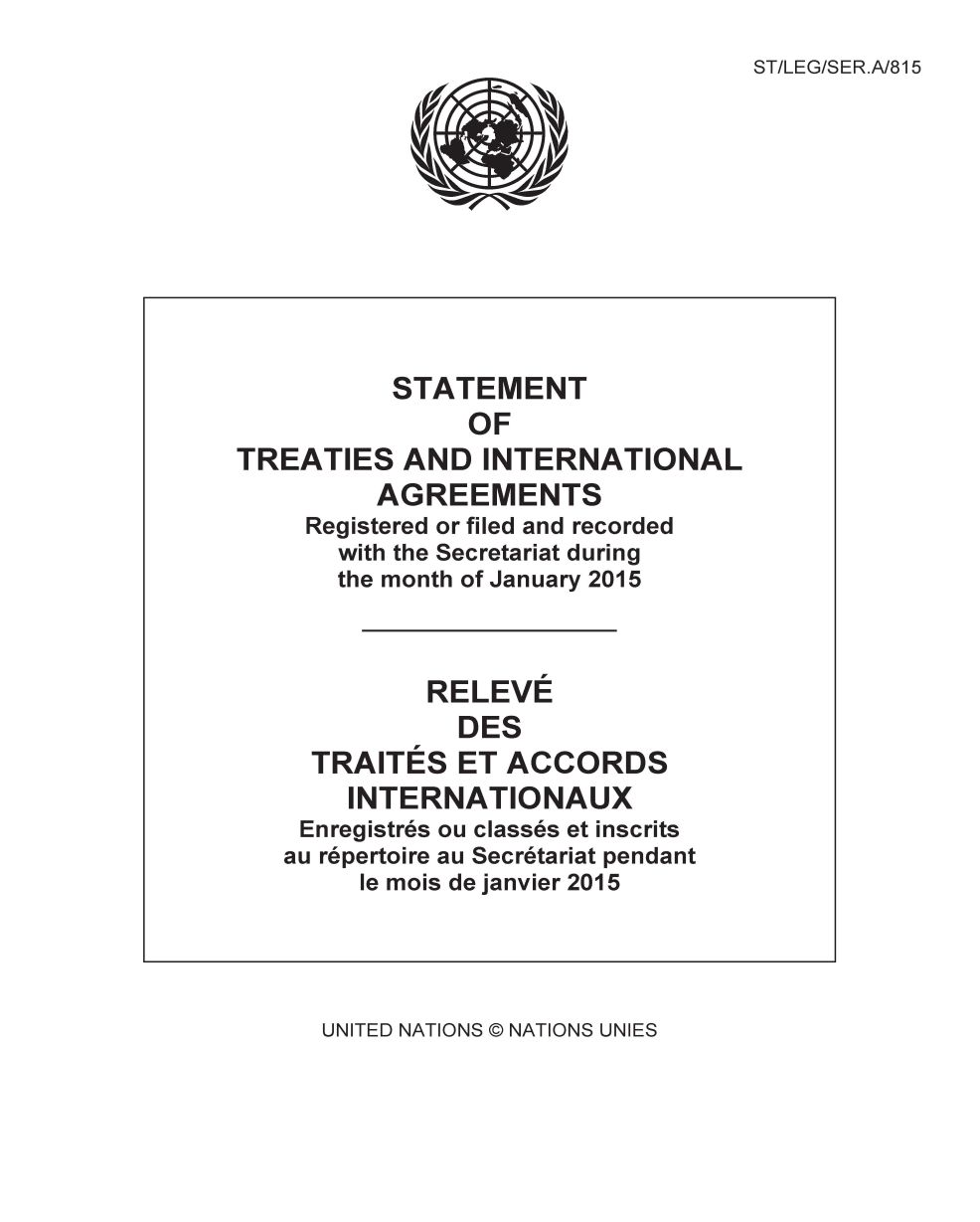 The Monthly statements are issued, in English and French, by the Treaty Section of the Office of Legal Affairs. These monthly statements contains detailed records of treaties and related subsequent treaty actions which were registered or filed and recorded with the Secretariat on a given month. It is updated monthly. The chronological range of the online collection is 1970 - present. The pdf version of the monthly statements are arranged in reverse chronological order. The user can browse by month, or search.
The Monthly statements are issued, in English and French, by the Treaty Section of the Office of Legal Affairs. These monthly statements contains detailed records of treaties and related subsequent treaty actions which were registered or filed and recorded with the Secretariat on a given month. It is updated monthly. The chronological range of the online collection is 1970 - present. The pdf version of the monthly statements are arranged in reverse chronological order. The user can browse by month, or search.


The depositary is required to provide treaty related information to all interested parties on the treaties deposited with him. The Secretary-General, as depositary of multilateral treaties, provides this information by issuing depositary notifications. Depositary notifications might be in regard to:
The database may be browsed or searched.
The Certified True Copies Database contains PDF version of the Certified True Copy (CTC) of each of the multilateral treaties for which the Secretary-General is a depositary (so-called ex-officio multilateral treaties). The CTC includes the treaty translated into all the official languages of the treaty.
For most research purposes, it is not necessary to consult a CTC, as the UNTS reprints the text of the CTC.
The CTC database may be accessed by browsing or searching.
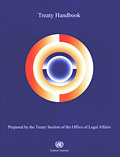 This publication has been prepared by the Treaty Section of the Office of Legal Affairs as a guide to the Secretary-General's practice as a depositary of multilateral treaties and the Secretariat's practice in relation to the registration and publication functions. It is particularly useful for its straightforward and practice-oriented definitions.
This publication has been prepared by the Treaty Section of the Office of Legal Affairs as a guide to the Secretary-General's practice as a depositary of multilateral treaties and the Secretariat's practice in relation to the registration and publication functions. It is particularly useful for its straightforward and practice-oriented definitions.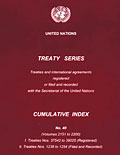 Treaty series. Cumulative index.
by
Treaty series. Cumulative index.
by
The United Nations Treaty Series (UNTS) is a collection of treaties and international agreements registered or filed and recorded with and published by the Secretariat since 1946, pursuant to Article 102 of the Charter. The UNTS includes the texts of treaties in their authentic language(s), along with translations into English and French, as appropriate. The collection currently contains over 158,000 records of treaties and related subsequent actions combined which have been published in hard copy in over 2,500 volumes. Currently, the UNTS is being expanded to include the latest desktop published volumes. Its online version covers the range of materials published from December 1946 to April 2008.
UNTC Title Search

- from the Title Search Tab, type in the exact title (select match phrase) or a few key words (select match all these words)
- NOTE: this search returns the main treaty document AND subsequent and related documents.
- NOTE: the title search is not always effective, especially for older treaty documents that may be lacking good metadata.
Whether you are searching through the UNTS or browsing the MTDSG, the treaty record is the same and contains valuable information for the researcher. The UN Office of Legal Affairs has a webpage explaining the information found in the treaty record.
Once you have conducted your search, you will see a brief list of treaties. You can re-order your list by clicking on one of the other headings.

The Registration Number is assigned to the treaty by the Treaty Section of the Secretariat when a member state submits a treaty for registration. Registation is required before a treaty can be invoked before the ICJ or any other organ of the UN. Registration numbers beginning with the letter "I" refer to treaty 'instruments' and numbers beginning with the letter "A" refer to treaty 'annexes'. Important information is often included in the annexes, so these documents should not be overlooked in your research.
Click on the relevant title to go to the Treaty Record.

The treaty record is the same whether you go through the MTDSG or the UNTS. At the top of the record, you see some basic information. The "STATUS AS AT" information displays the current time (e.g. the time you ran the search) and does not mean that treaty gnomes are updating status information for treaties 24-7. Generally, information is updated within the month. Next comes the chapter information for the MTDSG, the official title of the treaty, and the place and date on whic it was concluded.
The entry into force date comes next. This date is negotiated as part of the treaty and so reference is made to the appropriate article. Note the registration date is the same as the entry into force date. This is because a treaty cannot be registered with with the Secretary General until it has entered into force. The Status information provides a summary of the number of Signatories (those supportive of the idea) and Parties (those legally bound).
The next section, entitled "Text" is important. It is akin to the legislative history of a domestic law. It begins with the initial publication (and translated copies) of the treaty in the UNTS with volume and page number (what you need to construct a BlueBook citation!). Next, listed in chronological order, are all the subsequent depository notifications (C.N.) made by the parties ammending the text and associated annexes of the treaty.
Individual Country Ratification Information

Beneath the identifying information and treaty amendments comes the status information for participating individual countries. This information is important for understanding a country's legal obligation under the treaty. While this information is updated, there is some lag. If you suspect a country's status has changed, check with another authoritative source such as that country's state department or office of foreign affairs. In the example above, Afghanistan was a signatory to the treaty (likely participating in the treaty negotiation) but never ratified the treaty through their domestic process. Albania was not a signatory to the treaty but did acede to if after it entered into force.

Algeria aceded to the treaty after it entered into force, but it did so with a RUD (Reservation, Understanding, or Declaration). A RUD is a unilateral statement by the country, made when joining the treaty, which purports to modify or exclude the legal effects of some portion of the treaty. Some treaties prohibit RUDs. In the example of Algeria aceding to the Basel Convention, Algeria included a declaration stating that both parties must agree to submit a dispute to the ICJ or an arbitral body before that body has any jurisdiction. The RUD is hyperlinked from Algeria's name in the status table and all the Declarations are listed in a table immediately following the status information.
Argentina has dates in both columns, meaning it was both a signatory and went through the domestic process of ratification. A detailed explanation of the status information is available in the UN Treaty Handbook.
Multilateral Treaties Deposited with the Secretary General (MTDSG): Information on the status of over 500 major multilateral instruments deposited with the Secretary-General of the United Nations (as of 1 January 2009) and covers a range of subject matter such as Human Rights, Disarmament, Commodities, Refugees, the Environment and the Law of the Sea. The number of treaties deposited with the Secretary-General keeps growing steadily. This publication reflects the status of these instruments, as Member States sign, ratify, accede or lodge declarations, reservations or objections. It is over one thousand pages in length and is published annually in hard copy (three volumes). The on-line version is currently updated daily.
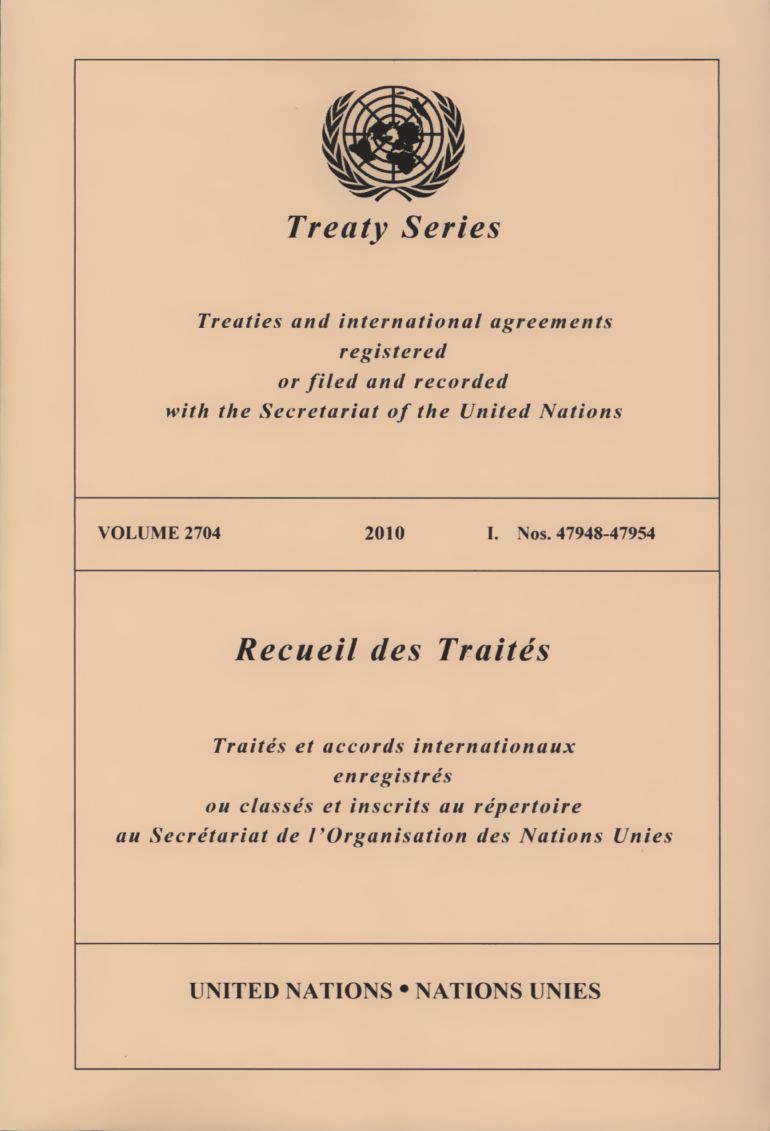 The United Nations Treaty Series (UNTS) is a collection of treaties and international agreements registered or filed and recorded with and published by the Secretariat since 1946, pursuant to Article 102 of the Charter. The UNTS includes the texts of treaties in their authentic language(s), along with translations into English and French, as appropriate. The collection currently contains over 158,000 records of treaties and related subsequent actions combined which have been published in hard copy in over 2,500 volumes. Currently, the UNTS is being expanded to include the latest desktop published volumes. Its online version covers the range of materials published from December 1946 to April 2008.
The United Nations Treaty Series (UNTS) is a collection of treaties and international agreements registered or filed and recorded with and published by the Secretariat since 1946, pursuant to Article 102 of the Charter. The UNTS includes the texts of treaties in their authentic language(s), along with translations into English and French, as appropriate. The collection currently contains over 158,000 records of treaties and related subsequent actions combined which have been published in hard copy in over 2,500 volumes. Currently, the UNTS is being expanded to include the latest desktop published volumes. Its online version covers the range of materials published from December 1946 to April 2008.
Whether you are searching through the UNTS or browsing the MTDSG, the treaty record is the same and contains valuable information for the researcher. The UN Office of Legal Affairs has a webpage explaining the information found in the treaty record.
Once you have conducted your search, you will see a brief list of treaties. You can re-order your list by clicking on one of the other headings.

The Registration Number is assigned to the treaty by the Treaty Section of the Secretariat when a member state submits a treaty for registration. Registation is required before a treaty can be invoked before the ICJ or any other organ of the UN. Registration numbers beginning with the letter "I" refer to treaty 'instruments' and numbers beginning with the letter "A" refer to treaty 'annexes'. Important information is often included in the annexes, so these documents should not be overlooked in your research.
Click on the relevant title to go to the Treaty Record.

The treaty record is the same whether you go through the MTDSG or the UNTS. At the top of the record, you see some basic information. The "STATUS AS AT" information displays the current time (e.g. the time you ran the search) and does not mean that treaty gnomes are updating status information for treaties 24-7. Generally, information is updated within the month. Next comes the chapter information for the MTDSG, the official title of the treaty, and the place and date on whic it was concluded.
The entry into force date comes next. This date is negotiated as part of the treaty and so reference is made to the appropriate article. Note the registration date is the same as the entry into force date. This is because a treaty cannot be registered with with the Secretary General until it has entered into force. The Status information provides a summary of the number of Signatories (those supportive of the idea) and Parties (those legally bound).
The next section, entitled "Text" is important. It is akin to the legislative history of a domestic law. It begins with the initial publication (and translated copies) of the treaty in the UNTS with volume and page number (what you need to construct a BlueBook citation!). Next, listed in chronological order, are all the subsequent depository notifications (C.N.) made by the parties ammending the text and associated annexes of the treaty.
Individual Country Ratification Information

Beneath the identifying information and treaty amendments comes the status information for participating individual countries. This information is important for understanding a country's legal obligation under the treaty. While this information is updated, there is some lag. If you suspect a country's status has changed, check with another authoritative source such as that country's state department or office of foreign affairs. In the example above, Afghanistan was a signatory to the treaty (likely participating in the treaty negotiation) but never ratified the treaty through their domestic process. Albania was not a signatory to the treaty but did acede to if after it entered into force.

Algeria aceded to the treaty after it entered into force, but it did so with a RUD (Reservation, Understanding, or Declaration). A RUD is a unilateral statement by the country, made when joining the treaty, which purports to modify or exclude the legal effects of some portion of the treaty. Some treaties prohibit RUDs. In the example of Algeria aceding to the Basel Convention, Algeria included a declaration stating that both parties must agree to submit a dispute to the ICJ or an arbitral body before that body has any jurisdiction. The RUD is hyperlinked from Algeria's name in the status table and all the Declarations are listed in a table immediately following the status information.
Argentina has dates in both columns, meaning it was both a signatory and went through the domestic process of ratification. A detailed explanation of the status information is available in the UN Treaty Handbook.
The MTDSG allows for an Advanced Search, an Index Search, a full text search, and a search by participant.
While the Advanced Search screens in the UNTS and MTDSG are similarly structured, the quality of the search results in the MTDSG are much higher. One suspects this is due to the smaller number of treaties contained in the MTDSG.
Advanced Search

Full Text Search
The Full-text Search does search through the PDF treaty documents. You can search for single words or for exact phrases. The resulting list shows you both the UN and LON multilateral treaties containing your word, but not where it appears or how frequently. Once the PDF of the treaty is opened, you must conduct the search in your PDF reader again to locate the word or phrase.
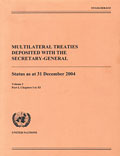 Multilateral Treaties Deposited with the Secretary General (MTDSG): Information on the status of over 500 major multilateral instruments deposited with the Secretary-General of the United Nations (as of 1 January 2009) and covers a range of subject matter such as Human Rights, Disarmament, Commodities, Refugees, the Environment and the Law of the Sea. The number of treaties deposited with the Secretary-General keeps growing steadily. This publication reflects the status of these instruments, as Member States sign, ratify, accede or lodge declarations, reservations or objections. It is over one thousand pages in length and is published annually in hard copy (three volumes). The on-line version is currently updated daily.
Multilateral Treaties Deposited with the Secretary General (MTDSG): Information on the status of over 500 major multilateral instruments deposited with the Secretary-General of the United Nations (as of 1 January 2009) and covers a range of subject matter such as Human Rights, Disarmament, Commodities, Refugees, the Environment and the Law of the Sea. The number of treaties deposited with the Secretary-General keeps growing steadily. This publication reflects the status of these instruments, as Member States sign, ratify, accede or lodge declarations, reservations or objections. It is over one thousand pages in length and is published annually in hard copy (three volumes). The on-line version is currently updated daily.The default page when you enter the MTDSG contains the UN treaties by topic.

To the left is a tab containing excellent introductory information: an explanation of the scope of the MTDSG and summary of the types of status a country may have in relation to a treaty.
Immediately to the right, are the League of Nation (LON) treaties. Historical Information covers sovereignty and territorial changes for countries. The INDEX is organized by MTDSG Reference number and can also be searched. The search options are discussed below.
When looking at the default page, UN treaties by topic, you can see that the treaties have been organized into 29 chapters by topic. If we want to find the Basel Convention on the Control of Transboundary Movements of Hazardous Wastes and their Disposal, we would first browse through the list of topics.

Transport & Communication and Environment both seem like potential Chapters where the Basel Convention might be listed, since it is about the movement of hazardous waste.

Most likely, if you have the name of a specific convention, you will just search for it. However, if you know that there is a treaty dealing with hazardous waste, but don't have an exact name, then browsing is a good option. This treaty is more about the topic of hazardous waste than it is about transportation, so select the hyperlinked chapter 27 for Environment treaties.
Once you locate the Basel Convention (listed as the 3rd set of agreements here), click on the title to go to the MTDSG/UNTS record page.

The treaty record is the same whether you go through the MTDSG or the UNTS. At the top of the record, you see some basic information. The "STATUS AS AT" information displays the current time (e.g. the time you ran the search) and does not mean that treaty gnomes are updating status information for treaties 24-7. Generally, information is updated within the month. Next comes the chapter information for the MTDSG, the official title of the treaty, and the place and date on whic it was concluded.
The entry into force date comes next. This date is negotiated as part of the treaty and so reference is made to the appropriate article. Note the registration date is the same as the entry into force date. This is because a treaty cannot be registered with with the Secretary General until it has entered into force. The Status information provides a summary of the number of Signatories (those supportive of the idea) and Parties (those legally bound).
The next section, entitled "Text" is important. It is akin to the legislative history of a domestic law. It begins with the initial publication (and translated copies) of the treaty in the UNTS with volume and page number (what you need to construct a BlueBook citation!). Next, listed in chronological order, are all the subsequent depository notifications (C.N.) made by the parties ammending the text and associated annexes of the treaty.
Individual Country Ratification Information

Beneath the identifying information and treaty amendments comes the status information for participating individual countries. This information is important for understanding a country's legal obligation under the treaty. While this information is updated, there is some lag. If you suspect a country's status has changed, check with another authoritative source such as that country's state department or office of foreign affairs. In the example above, Afghanistan was a signatory to the treaty (likely participating in the treaty negotiation) but never ratified the treaty through their domestic process. Albania was not a signatory to the treaty but did acede to if after it entered into force.

Algeria aceded to the treaty after it entered into force, but it did so with a RUD (Reservation, Understanding, or Declaration). A RUD is a unilateral statement by the country, made when joining the treaty, which purports to modify or exclude the legal effects of some portion of the treaty. Some treaties prohibit RUDs. In the example of Algeria aceding to the Basel Convention, Algeria included a declaration stating that both parties must agree to submit a dispute to the ICJ or an arbitral body before that body has any jurisdiction. The RUD is hyperlinked from Algeria's name in the status table and all the Declarations are listed in a table immediately following the status information.
Argentina has dates in both columns, meaning it was both a signatory and went through the domestic process of ratification. A detailed explanation of the status information is available in the UN Treaty Handbook.